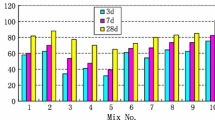Abstract
Durability of concrete can be improved by applying surface treatments. Pore-lining treatments prevent or delay the ingress of water-borne salts while allowing vapour transfer across the concrete surface. The most common pore-liners are silanes and siloxanes; both reported to give good results. One area of concern, however, is variability in effectiveness of the treatment. This variability may be due to inconsistent coverage or extreme drying conditions. With care these can be controlled but another source of variability which is difficult to control is the moisture profile within the concrete at the time of application of the treatment. This paper describes a test programme to assess the sensitivity of three different surface treatments to moisture gradient in the concrete at the time of application of treatment. The test programme included durability parameters such as chloride ingress, corrosion due to chloride ingress, freeze–thaw salt scaling resistance. Water absorption (sorptivity) of treated and untreated concretes was also measured with a non-distructive test technique called Autoclam with the aim of determining if the Autoclam sorptivity test can be used to assess the effectiveness of surface treatments. Using these results it is possible to avoid, or allow for, moisture conditions which would adversely affect the success of a pore-liner. However there are advantages in specifying an expected performance of the surface treatment rather than specifying the conditions in which it must be placed. By this method a treatment would have to achieve a specified value of sorptivity or a specified reduction in sorptivity. Failure to do so would be an objective basis on which to make a decision of whether or not to reject the treatment. The Autoclam is a device capable of measuring sorptivity values down to the range typical of surface treated concrete. The paper assesses if the device can be used to discriminate between acceptable treatment and unsatisfactory treatments.








Similar content being viewed by others
References
ACI (1987) Corrosion of metals in concrete. ACI special publication SP-49, September 1987. American Concrete Institute, Detroit, p 136
Gonzalez JA et al (1990) On the mechanism of steel corrosion in concrete: the role of oxygen diffusion. Magazine of concrete research, London, pp 23–27
Bakker RFM (1988) Initiation period. Report of the technical committee 60 CSC, RILEM. Chapman and Hall, London, p 98
Berke NS, Pfeifer DW (1988) Protection against chloride induced corrosion, December, 1988. Concrete International, Alberta, pp 45–55
Berke NS, Hickes MC (1994) Use of laboratory techniques to evaluate long-term durability of steel reinforced concrete exposed to chloride ingress. In: 3rd international conference-durability of concrete, ACI SP-145. Nice, France, pp 299–330
CFIT (1976) Guides to practice in corrosion control—the corrosion of steel and its monitoring in concrete. Department of Industry in Association with the Institution of Corrosion Science and Technology, UK, p 5
Pfeifer DW, Landgren JR (1987) Protective systems for new prestressed and substructure concrete. Department of Transportation, NCHRP 244, Washington, FHWA/RD-86/193, p 138
McGettigan E (1992) Silican based weather proofing materials. Concrete International, Canada, pp 52–56
Roth M (1986) Siliconates-silicone resins-silanes-siloxanes. Silicone masonry water repellents for the surface inpregnation of mineral building materials, seminar “concrete and masonry protection,” Organised by Thames Valley Section of the Oil Colour Chemists Association, Castle Hotel, Windsor, p 10
Smith MD (1986) Silane chemical protection of bridge decks. R&D Division Oklahoma Department of Transportation, USA, FHWA/OK 86(4), p 42
Basheer PAM, Long AE, Montgomary FR (1994) The Autoclam––a new test for permeability, concrete, July/August 1994. Journal of the Concrete Society, England, pp 27–29
Basheer L, Cleland DJ, Basheer PAM, Harmon N (2008) Permeability system to assess the protection provided by surface treatments. In: Jin WL, Udea T, Basheer PAM (eds) Advances in concrete structural durability. Proceedings of the international conference on durability of concrete structures, 26–27 November 2008, ICDCS 2008. Zhejiang University Press, Hangzhou, pp 1186–1192
British Standards Institution (BSI) (1992) Specification for aggregates from natural sources for concrete. BSI London, BS 882:1992
Basheer L, Cleland DJ, Long AE (1998) Protection provided by surface treatments against chloride induced corrosion. Mater Struct 31:459–464
British Standards Institution (BSI) (1988) Methods for analysis of hardened concrete. British Standards Institution, BS 1881: part 124, p 21
Setzer MJ, Fegerlund G, Janssen DJ (1996) CDF test-test method for freeze-thaw resistance of concrete-tests with sodium chloride solution (CDF). Mater Struct 29:523–528
Basheer L, Cleland DJ (2006) Freeze-thaw resistance of concretes treated with pore-liners. Constr Build Mater 20(10):990–998
Basheer L, Kropp J, Cleland DJ (2001) Assessment of the durability of concrete from its permeation properties: a review. Constr Build Mater 15:93–103
Acknowledgement
The funding provided by Engineering and Physical Sciences Research Council (UK) and materials provided by Fosroc to carry out this study is greatly acknowledged.
Author information
Authors and Affiliations
Corresponding author
Rights and permissions
About this article
Cite this article
Basheer, L., Cleland, D.J. Durability and water absorption properties of surface treated concretes. Mater Struct 44, 957–967 (2011). https://doi.org/10.1617/s11527-010-9679-4
Received:
Accepted:
Published:
Issue Date:
DOI: https://doi.org/10.1617/s11527-010-9679-4




